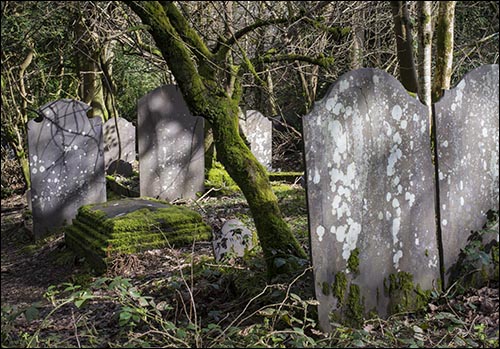Abandoned cemetery, Bethesda
 North of the footpath near here lies the abandoned Tanysgrafell (or Tanysgafell) Cemetery, which had its own chapel. You may walk through the woods to the cemetery (which still belongs to the Church in Wales) but please take care on the uneven ground.
North of the footpath near here lies the abandoned Tanysgrafell (or Tanysgafell) Cemetery, which had its own chapel. You may walk through the woods to the cemetery (which still belongs to the Church in Wales) but please take care on the uneven ground.
The area’s original mother church, St Ann's, was built in 1812 (later buried by the nearby slate tips) but had no graveyard. On 9 March 1848 Tanysgrafell Cemetery was consecrated by the Bishop of Bangor, accompanied by 240 children from Pont y Tŵr School. The chapel was “no longer in use” by 1965, and it was apparently demolished soon after.
The earliest grave identified is that of Ann Roberts, aged 2, of Craiglwyd, Mynydd Llandegai, buried 2 May 1848; the latest that of Jane Jones, 91, of Bryneglwys, St Ann’s, buried 31 May 1913.
Charles Jones, master of Pont y Tŵr School, buried two of his children here within six days in 1852. One, aged 10, had fallen down a cliff to his death shortly before the other, aged 15 months, died of whooping cough.
In 1904 one of the area’s oldest residents was buried here. Humphrey Jones, 95, had witnessed construction of Thomas Telford’s road (now the A5) and lived latterly at Ogwen Bank, where he was gamekeeper from 1871.
A fracas near the cemetery one Saturday night in 1858 led to police constable Edward Jones being charged with highway robbery! Quarryman John Roberts, who owed PC Jones money, was on his way home after an evening of drinking in Bethesda when, he claimed, the constable and an accomplice ambushed him, stole his neckerchief and money and “knocked him about”. Due to conflicting evidence and Roberts’ drunken state, PC Jones was acquitted.
In 1883 vandals attacked the “pretty little cemetery chapel”, breaking the large east window. Its isolated position meant there were no houses nearby “to protect it from such lawlessness”.
Although it had a thriving Sunday School, its accommodation was inadequate. By 1888 it was disused. It reopened in 1889, after Lord Penrhyn funded renovations and the building of a new transept.
In November 1914 the chapel hosted an entertainment by the St Ann’s Band of Mercy, raising money for Belgian refugees. “Belgian ladies now quartered at Bangor” were in the audience.
With thanks to Hazel Pierce, of The History House. Sources include the survey of grave inscriptions by Gwynedd Family History Society. Thanks also to David Shipley


